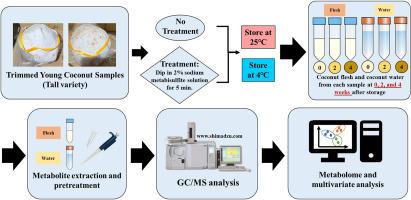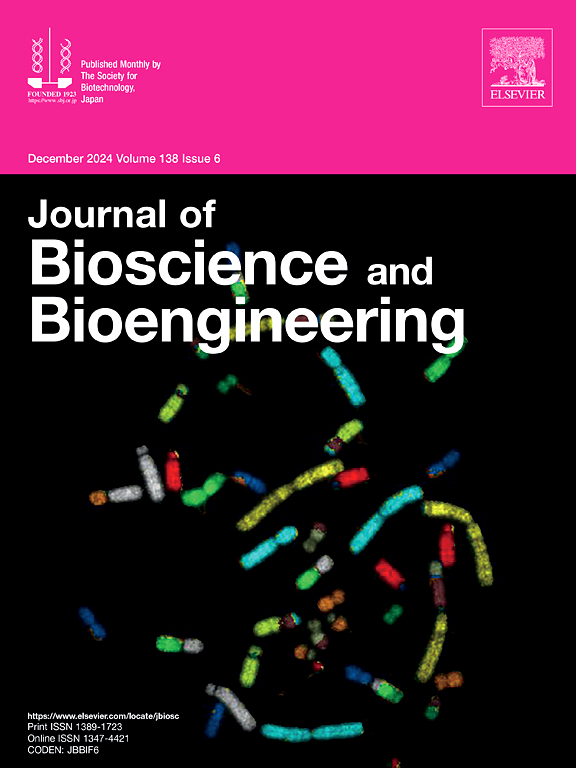Effect of sodium metabisulfite treatment and storage condition on metabolic profile of young coconut (Cocos nucifera L.)
IF 2.3
4区 生物学
Q3 BIOTECHNOLOGY & APPLIED MICROBIOLOGY
引用次数: 0
Abstract
Young coconuts (Cocos nucifera L.) used for export are trimmed to reduce their size and weight to lower transport costs. However, trimmed coconuts have a shorter shelf life due to microbial spoilage and surface discoloration caused by enzymatic browning. To minimize these effects, trimmed coconuts were dipped in an anti-browning agent, sodium metabisulfite (SMB), and stored under ambient conditions. However, there have been no reports on the effects of SMB treatment on metabolome changes in the flesh and water of young coconuts. Hence, this study investigated the metabolite changes in trimmed young coconuts after SMB treatment under different storage conditions using a gas chromatography (GC)/mass spectrometry (MS) metabolomic profiling approach. Tall young coconut samples were trimmed and treated with a 2% SMB solution for 5 min before storage at 25 °C or 4 °C for 2–4 weeks. Coconut flesh and water samples were collected after storage for 0, 2, and 4 weeks, and were subjected to GC–MS analysis. The results showed that the major metabolites affected by coconut deterioration were amino acids, sugars, and sugar alcohols. SMB treatment and/or refrigeration can help prevent metabolite changes in the flesh and water of young coconuts. In the future, improvements in storage conditions based on metabolite profiles should be explored.

焦亚硫酸钠处理和储存条件对椰子(Cocos nucifera L.)新陈代谢的影响
用于出口的新椰子(Cocos nucifera L.)要经过修剪,以减小体积和重量,降低运输成本。然而,由于微生物腐败和酶促褐变造成的表面褪色,修剪过的椰子保质期较短。为了尽量减少这些影响,将修剪过的椰子浸泡在防褐变剂焦亚硫酸钠(SMB)中,并在环境条件下储存。然而,目前还没有关于 SMB 处理对椰果幼果果肉和水分中代谢组变化的影响的报道。因此,本研究采用气相色谱(GC)/质谱(MS)代谢组分析方法,研究了在不同贮藏条件下经过 SMB 处理的修剪过的幼椰子中代谢物的变化。高大的幼椰子样品经修剪后用 2% 的 SMB 溶液处理 5 分钟,然后在 25 °C 或 4 °C 下贮藏 2-4 周。椰肉和水样品在贮藏 0 周、2 周和 4 周后采集,并进行气相色谱-质谱分析。结果表明,受椰子变质影响的主要代谢物是氨基酸、糖和糖醇。SMB 处理和/或冷藏有助于防止幼椰子果肉和水分中代谢物的变化。今后,应根据代谢物概况探索如何改善贮藏条件。
本文章由计算机程序翻译,如有差异,请以英文原文为准。
求助全文
约1分钟内获得全文
求助全文
来源期刊

Journal of bioscience and bioengineering
生物-生物工程与应用微生物
CiteScore
5.90
自引率
3.60%
发文量
144
审稿时长
51 days
期刊介绍:
The Journal of Bioscience and Bioengineering is a research journal publishing original full-length research papers, reviews, and Letters to the Editor. The Journal is devoted to the advancement and dissemination of knowledge concerning fermentation technology, biochemical engineering, food technology and microbiology.
 求助内容:
求助内容: 应助结果提醒方式:
应助结果提醒方式:


